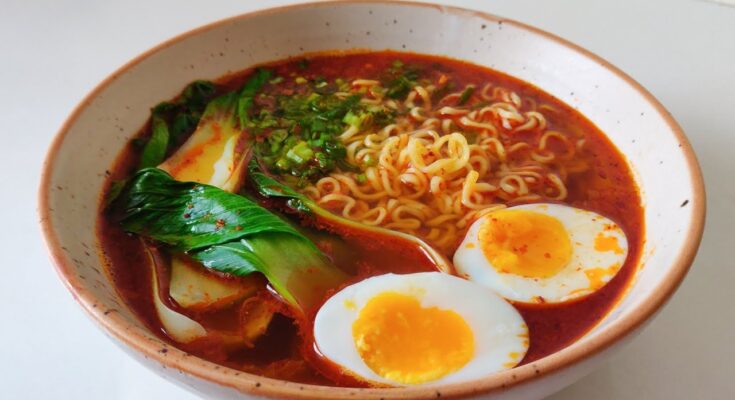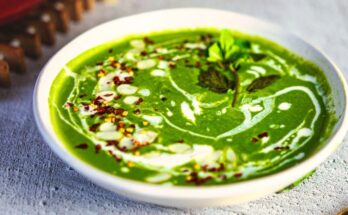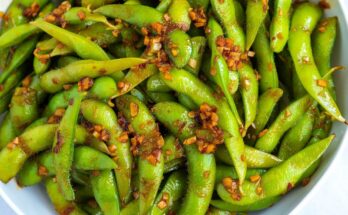Spicy Ramen Recipe: Spicy ramen isn’t just a passing food trend—it’s a global obsession. From the bustling streets of Tokyo to the late-night noodle bars in New York, spicy ramen has carved its place in the hearts (and stomachs) of foodies everywhere. This fiery dish, once confined to Japanese kitchens, has evolved into a culinary sensation that crosses cultural boundaries. Why? Because spicy ramen delivers an unmatched combination of rich umami flavor, satisfying heat, and slurp-worthy noodles.
The global love for ramen isn’t just about convenience; it’s about comfort. And when you add a spicy twist to the classic, you take that comfort to a whole new level. It’s bold, it’s brash, and it makes your tastebuds dance. Whether you’re a heat-seeker or just want to warm up on a cold day, spicy ramen hits all the right notes.
Social media has also played a major role in its popularity. From viral mukbang videos to food challenge trends, spicy ramen has taken over timelines and taste tests alike. But here’s the best part—you don’t need to order out or go to a specialty restaurant to get that authentic spicy ramen experience. You can make it right at home.
Why Make Spicy Ramen at Home?
There’s something truly satisfying about crafting your own bowl of spicy ramen. Not only can you tailor it to your exact spice tolerance and flavor preference, but you also have full control over the ingredients. Want to keep it vegetarian? No problem. Craving extra protein? Easy fix. Prefer a tongue-tingling heat level that makes your eyes water? Go for it.
Making ramen at home is also surprisingly quick and budget-friendly. Forget overpriced takeout. With a few pantry staples and about 30 minutes of your time, you can whip up a dish that tastes like it came straight from a Tokyo ramen bar.
Plus, there’s something magical about assembling your own bowl—layering in the noodles, ladling over the steaming broth, topping it with a perfectly soft-boiled egg, crunchy scallions, and maybe a sprinkle of sesame seeds. It’s comfort food, redefined.
So, if you’re ready to make a bowl of spicy ramen that’ll impress your taste buds and your Instagram followers, keep reading.
List of Ingredients You’ll Need
Basic Ramen Ingredients
Let’s break down the essentials. These are the foundation of any solid bowl of spicy ramen:
- Ramen Noodles – Go for fresh if you can, but instant works in a pinch.
- Broth – Chicken, pork, vegetable, or dashi stock. You want a rich base.
- Garlic – Freshly minced for bold flavor.
- Ginger – Adds depth and warmth.
- Soy Sauce – For saltiness and umami.
- Sesame Oil – Adds nutty richness.
- Scallions (Green Onions) – Chopped for garnish and added bite.
- Soft-Boiled Eggs – Marinated or plain, they’re the ramen MVP.
- Vegetables – Bok choy, mushrooms, corn, bean sprouts, etc.
These are your starting blocks. From here, we layer in the heat.
Spicy Boosters: The Key to Heat
Now for the fire! These ingredients bring the signature burn:
- Chili Garlic Sauce – Bold and spicy.
- Gochujang (Korean Chili Paste) – Slightly sweet, fermented heat.
- Red Pepper Flakes or Powder – Customizable kick.
- Sriracha – Tangy, spicy, and accessible.
- Fresh Chili Peppers (optional) – For serious spice lovers.
- Chili Oil – Adds flavor and fire with just a drizzle.
Feel free to adjust the quantity depending on your spice tolerance. Start low and build up—there’s no shame in sweating it out.
Optional Toppings to Elevate Your Bowl
Want to take your spicy ramen to gourmet level? Consider these toppings:
- Nori Sheets (Seaweed) – Adds oceanic depth.
- Sesame Seeds – For crunch and nuttiness.
- Bamboo Shoots – For texture.
- Pickled Ginger or Radish – Cuts through the richness.
- Tofu or Tempeh – Vegetarian protein options.
- Grilled Chicken or Pork Belly – Classic ramen proteins.
Toppings allow you to personalize your bowl. Think of them as your ramen’s signature.
Kitchen Tools You’ll Need
Cooking Essentials
Before diving into the recipe, make sure your kitchen is stocked with these tools:
- Large Pot – For boiling broth and noodles.
- Medium Saucepan – For preparing the spicy paste or oil.
- Fine Mesh Strainer – If you’re making broth from scratch.
- Ladle – For serving broth.
- Tongs or Chopsticks – To serve noodles easily.
- Knife & Cutting Board – For prepping veggies and proteins.
- Timer – Crucial for perfect soft-boiled eggs.
Optional Tools That Make Life Easier
If you’re a ramen fanatic, these tools are worth the investment:
- Ramen Bowls – Wide and deep for the full ramen experience.
- Ramen Spoons (Chirirenge) – Scoop up broth and bits with ease.
- Egg Timer or Sous Vide – For next-level eggs.
- Spice Grinder – For fresh red pepper flakes or garlic-chili paste.
Having the right tools makes the process smoother—and your presentation sharper.
Step-by-Step Guide to Making Spicy Ramen
Step 1: Preparing the Broth Base
Start by heating chicken or vegetable broth in a pot over medium heat. Add soy sauce, minced garlic, grated ginger, and a dash of sesame oil for depth. Let it simmer gently so the flavors meld beautifully.
Step 2: Building the Spicy Paste
In a small bowl, mix chili paste, gochujang, or sriracha with a bit of oil and sugar. This spicy blend brings the ramen’s signature kick and color.
Step 3: Cooking the Noodles Just Right
Boil ramen noodles separately until al dente — tender but still firm. Drain and set aside.
Step 4: Combining Broth and Paste
Whisk the spicy paste into the simmering broth until fully dissolved, creating a rich, fiery soup.
Step 5: Assembling the Final Bowl
Add noodles to the bowl, pour in the hot broth, and top with soft-boiled egg, scallions, and chili oil for that restaurant-quality finish.
Expert Tips for Perfect Spicy Ramen
Balancing Spice with Flavor
One of the biggest misconceptions about spicy ramen is that it’s all about blowing your taste buds away with sheer heat. But the truth? Great spicy ramen isn’t just hot—it’s flavorful. The key is balance. You want every spoonful to be a dance between spice, umami, and richness—not a firestorm that numbs your tongue after the first bite.
Here’s how to find that perfect balance:
- Layer your spice: Don’t dump all your heat in at once. Start with a little chili garlic paste or gochujang, then adjust upward. Taste constantly.
- Use sweetness strategically: A teaspoon of sugar or mirin balances the salt and spice, mellowing the edge of fiery ingredients.
- Salt smartly: Soy sauce adds salt and umami, but too much can overpower the dish. Add in small splashes.
- Add acidity: A tiny splash of rice vinegar or lime juice brightens the broth and cuts through the richness of fatty toppings like pork belly or egg yolk.
Think of spicy ramen like a good song—every element needs to be in harmony for it to hit just right.
Preventing Overcooking
There’s nothing worse than soggy noodles in an otherwise perfect bowl of ramen. Overcooking doesn’t just kill the texture; it can also dull the spice and make the broth feel murky.
Tips to avoid overcooking:
- Cook noodles separately from the broth. This prevents them from continuing to absorb liquid after being added.
- Rinse noodles under cold water once cooked. This halts cooking immediately and firms them up.
- Add noodles last. Assemble your bowl with cooked noodles first, then ladle hot broth over them to warm them up.
- Watch your simmer time. After you mix the spicy paste into your broth, let it simmer just enough to meld flavors—not boil for 30 minutes.
Perfect ramen is all about precision, and that starts with knowing when to stop cooking.
Best Noodles for Spicy Ramen
Let’s be real: the noodles are the star of the show. They carry the broth, soak in the flavor, and deliver that chewy, satisfying slurp we all crave.
Best noodle options:
- Fresh ramen noodles – The gold standard. They’re springy, chewy, and absorb flavor beautifully.
- Frozen ramen noodles – A great backup. Look for them in Asian grocery store freezer sections.
- Dry ramen noodles (without the seasoning packet) – Convenient and cheap, but pick quality brands like Nongshim or Myojo.
- Alternative options: If you’re gluten-free, try rice noodles (though they change the texture and experience a bit).
Avoid: Spaghetti or typical pasta. They don’t hold up well in broth and can get mushy quickly.
Storage Tip: If you’re prepping ahead, keep your noodles and broth separate until serving time to maintain ideal texture.
Customizing Your Spicy Ramen
Vegetarian and Vegan Versions
Don’t eat meat? No worries—you can still make a bowl of spicy ramen that’s deeply satisfying and full of flavor.
How to make it vegetarian or vegan:
- Use veggie broth as your base—go for one with mushrooms or kombu for added depth.
- Skip the eggs or use tofu-based vegan “egg” alternatives.
- Add plant-based proteins: Tofu (pan-fried or soft), tempeh, seitan, or edamame work great.
- Load up on veggies: Mushrooms, spinach, corn, bamboo shoots, bok choy, and scallions all add texture and nutrients.
Vegan spicy paste idea:
- Gochujang
- Chili garlic sauce
- Soy sauce
- Sesame oil
- Grated garlic and ginger
- A dash of maple syrup or sugar
Whisk it together and stir into your broth for a 100% plant-powered heat blast.
Protein Variations: Chicken, Pork, Tofu, Shrimp
Spicy ramen is incredibly versatile when it comes to proteins. Here are a few delicious ideas depending on your preference:
Chicken
- Grilled, shredded, or pan-fried
- Marinate in soy sauce, garlic, and sesame oil for extra flavor
Pork
- Classic chashu pork belly is a favorite (slow-braised in soy and mirin)
- Ground pork sautéed with chili oil adds a spicy, meaty texture
Tofu
- Use firm tofu, pan-fried until crispy
- Marinate in spicy soy glaze for added depth
Shrimp
- Quick-cooking and juicy
- Toss in chili oil and garlic, then sauté for a flavorful seafood twist
Pro Tip: Whatever protein you choose, cook it separately and add it to your bowl last. That way, it keeps its texture and doesn’t overcook in the broth.
Spice Level Adjustments for Everyone
Not everyone likes their ramen to set their mouth on fire—and that’s okay. Here’s how to customize the heat level for everyone at your table:
- Mild: Use half the spicy paste or skip sriracha/gochujang. Add a touch of honey or sugar to mellow it out.
- Medium: Follow the recipe as-is, adjusting to taste.
- Hot: Add extra chili flakes, fresh chili slices, or a spoonful of chili oil on top.
- Insane: Use ghost pepper or Carolina Reaper sauces—but only if you dare.
Always serve with extra chili oil or paste on the side so people can boost their bowl’s heat as they eat.
Common Mistakes to Avoid
Overpowering Heat
One of the biggest pitfalls in making spicy ramen? Going overboard with the spice. It’s tempting to load your bowl with chili paste, sriracha, and fresh peppers—but too much heat can completely drown out the beautiful umami and depth of the broth.
Here’s how to avoid this mistake:
- Add spice gradually: Always taste as you go. Add a small amount of spicy paste or chili oil, mix well, taste, then decide if it needs more.
- Know your ingredients: Some chili pastes are hotter than others. Gochujang, for instance, has a mild heat with a sweet, fermented flavor. Sambal oelek? Much hotter.
- Balance is key: For every spoonful of chili, consider adding something to balance it—like sugar, soy sauce, or sesame oil.
Ramen should be exciting, not painful. Don’t let the spice overpower the soul of the soup.
Wrong Noodle Choice
This mistake seems small but can make a huge difference in the final result. Not all noodles are created equal, especially when it comes to ramen.
Common mistakes:
- Using spaghetti or linguine – These absorb broth differently and lack the chewiness that makes ramen special.
- Overcooked instant noodles – These can become mushy and break apart in the broth.
- Too thick or too thin noodles – Balance is important; overly thick noodles don’t absorb broth well, while super-thin ones get soggy fast.
Best choice? Go for authentic ramen noodles from an Asian grocery store. If not available, opt for quality instant ramen and discard the flavor packet.
Not Tasting as You Go
This might be the #1 cooking rule in any recipe—and it’s especially true for spicy ramen. You’re working with powerful ingredients: soy sauce, miso, spicy chili pastes, garlic, and more. If you don’t taste frequently, you might end up with a broth that’s way too salty, too spicy, or just flat.
How to fix it:
- Taste after every addition. Every spoonful of paste, oil, or seasoning should be followed by a taste test.
- Adjust in small amounts. It’s easier to add more flavor than take it away.
- Serve garnishes and spice on the side so each diner can control their own spice level.
Treat ramen like a live performance—it’s constantly evolving and needs your direction from start to finish.
Health Benefits of Spicy Ramen
Believe it or not, your favorite comfort food can also be a bit of a health hero—especially when you load it up with fresh ingredients and balanced spice.
Nutritional Perks of Spices
Spicy ramen’s heat typically comes from ingredients like chili garlic paste, red pepper flakes, and gochujang—all of which contain capsaicin, a natural compound found in chili peppers. Capsaicin has been linked to several health benefits:
- Boosts metabolism – It helps your body burn calories more efficiently.
- Reduces inflammation – A potential natural remedy for chronic pain and joint discomfort.
- Improves digestion – Stimulates enzymes and gastric juices that aid in breaking down food.
- Heart health – Some studies show capsaicin helps lower cholesterol and blood pressure.
Boosting Nutrition with Whole Ingredients
You can easily level up your spicy ramen by incorporating nutrient-rich additions:
- Vegetables – Bok choy, mushrooms, carrots, and spinach bring fiber, vitamins, and minerals.
- Lean proteins – Grilled chicken, tofu, or even soft-boiled eggs offer quality protein without excessive fat.
- Whole grain or low-sodium noodles – A great swap for those watching sodium or carb intake.
The beauty of homemade ramen is that it’s entirely in your control. You can make it as indulgent or as healthy as you want. Spicy ramen doesn’t have to be junk food—it can be a warming, nourishing bowl that satisfies your cravings and your body.
Pairing Ideas: What Goes Well with Spicy Ramen
A bowl of spicy ramen is a showstopper on its own—but if you’re putting together a full meal or want to elevate your dinner table, consider these perfect pairings.
Best Drinks to Serve
Spicy food and the right drink go hand-in-hand. The goal is to cool your tongue without clashing with the bold flavors.
- Milk-based drinks: Iced milk tea or soy milk helps neutralize spice.
- Lemonade or citrus-infused water: Refreshing and balances the heat.
- Japanese beer: Light and crisp, perfect with spicy broth.
- Green tea: Helps cleanse the palate and aids digestion.
Avoid carbonated sodas—they can amplify the heat and discomfort from spicy foods.
Perfect Side Dishes
Want to turn ramen night into a complete experience? Here are a few side dishes that complement spicy ramen beautifully:
- Gyoza (Japanese dumplings) – Pan-fried dumplings with a crispy shell and juicy filling.
- Edamame – Lightly salted and perfect for snacking.
- Pickled vegetables – Kimchi, pickled daikon, or carrots add tang and crunch.
- Seaweed salad – Light, fresh, and full of umami.
- Tempura – Lightly battered shrimp or veggies add texture and contrast.
Together, these sides round out your meal without stealing the spotlight from your spicy ramen.
How to Store and Reheat Leftovers
Let’s be honest—sometimes you make too much ramen (on purpose), and that’s not a bad thing. But reheating it the right way is crucial to keeping the texture and flavor on point.
Storing Ramen Without Losing Flavor
- Separate the components: Store broth, noodles, and toppings in separate containers. This prevents sogginess and flavor loss.
- Use airtight containers: Keeps everything fresh and prevents the broth from absorbing odors from your fridge.
- Refrigeration time: Eat within 2–3 days for best taste and safety.
Reheating the Right Way
Reheating Broth:
- Pour broth into a saucepan and heat over medium until steaming. Avoid boiling, which can dull the spice and make the broth taste flat.
Reheating Noodles:
- Quickly rinse with hot water or reheat in a microwave-safe bowl with a splash of broth. Don’t overheat—they only need 30–60 seconds.
Reassembling:
- Place noodles in a bowl, add toppings, pour over hot broth, and enjoy like it was freshly made.
Want to freeze it? Freeze only the broth (not the noodles or toppings) for up to 2 months in a freezer-safe bag.
Ramen Around the World: Regional Variations
Ramen may have originated in Japan, but it has since become a global dish with exciting regional twists. If you’re a spicy ramen fan, these international versions will take your taste buds on a flavorful journey.
Korean-Style Spicy Ramen (Ramyeon)
Korean ramyeon is a spicier, bolder take on traditional ramen, often known for its rich red broth and powerful chili flavor.
Signature Features:
- Heavily seasoned broth with gochujang and chili flakes
- Kimchi added for tangy heat and fermented depth
- Often topped with processed cheese, egg, or spam
- Popular brands: Shin Ramyun, Samyang Hot Chicken Ramen
Pro Tip: Add a spoonful of kimchi and a slice of cheddar for a quick Korean-inspired spicy ramen bowl.
Japanese Tantanmen
Tantanmen is Japan’s answer to Chinese Sichuan Dan Dan noodles—a rich, creamy, spicy ramen loaded with sesame paste and ground pork.
Key Ingredients:
- Ground pork sautéed with chili oil and soy sauce
- Creamy broth made with tahini or sesame paste
- Spicy garlic and ginger paste for depth
- Often includes bok choy, green onions, and soft-boiled egg
This is a fantastic option for those who like a creamy, nutty, and spicy profile in their bowl.
Thai-Inspired Ramen
Thai ramen combines the vibrant, fragrant flavors of Thai cuisine with ramen’s structure. Think of it as a hybrid bowl that fuses sweet, spicy, and sour.
Highlights:
- Coconut milk-based broth for a creamy texture
- Infused with lemongrass, kaffir lime, and Thai chilies
- Topped with fresh cilantro, lime wedges, and shrimp
This version is incredibly aromatic and great for people who enjoy Tom Yum or Thai curry flavors.
Global Fusion Ideas
The beauty of ramen is how easily it adapts to local tastes. Try these fun fusion ideas:
- Mexican Spicy Ramen: Add chipotle peppers, black beans, corn, and queso fresco.
- Indian-Inspired Ramen: Use curry paste and paneer, with a turmeric-spiced broth.
- American BBQ Ramen: Mix in pulled pork, barbecue sauce, and crispy onions for a bold twist.
Spicy ramen isn’t bound by borders—your kitchen is your culinary playground.
Make It a Meal: Full Spicy Ramen Dinner Menu
Planning a ramen night at home? Let’s go all-in with a full meal that brings restaurant vibes straight to your kitchen.
Appetizers
- Gyoza (Dumplings): Pan-fried, crispy on the outside, juicy on the inside. Dip in soy-vinegar sauce.
- Seaweed Salad: Light, tangy, and packed with umami.
- Miso Soup: A gentle starter that won’t overwhelm the palate before the spice kicks in.
Main Course: Spicy Ramen
Serve a customizable ramen bar where each person can choose their spice level, protein, and toppings. This interactive setup makes dinner feel fun and personalized.
Suggestions:
- Base broth: Keep a mild broth and let each person add their own spicy paste
- Toppings station: Soft-boiled eggs, scallions, sesame seeds, nori, sautéed mushrooms
- Spice bar: Chili oil, sriracha, gochugaru, fresh sliced peppers
Dessert Pairings
After the heat, you’ll want to cool down with something refreshing.
- Green Tea Ice Cream: Creamy, bitter-sweet, and palate-cleansing
- Mango Sticky Rice: Sweet, chewy, and tropical
- Mochi: Fun and chewy rice cakes in a variety of flavors
Balance your fiery ramen with a sweet finish to complete the meal experience.
FAQs about Spicy Ramen Recipe
1. Can I make spicy ramen less spicy?
Absolutely! Simply reduce the amount of chili paste or sauce, and avoid adding fresh chili peppers. You can also balance the heat with sugar or a bit of coconut milk to mellow the spice.
2. What’s the best broth for spicy ramen?
Chicken broth is a popular base because it’s light and lets the spice shine. Pork broth adds richness, while veggie broth is great for plant-based versions. Adding miso or soy sauce deepens the flavor regardless of the base.
3. How long does spicy ramen last in the fridge?
Spicy ramen components (broth, noodles, and toppings) last up to 3 days if stored separately in airtight containers. Avoid storing assembled bowls to prevent soggy noodles.
4. Can I freeze spicy ramen?
You can freeze the broth for up to 2 months. Do not freeze the noodles—they lose texture. Prepare fresh noodles when reheating the broth.
5. What type of chili paste is best for ramen?
Gochujang is excellent for a sweet-heat profile. Chili garlic sauce is bolder and more pungent. Sriracha is a mild, tangy option. Mix and match to find your perfect flavor combo.
Conclusion
There’s something magical about a bowl of spicy ramen. It’s not just the heat—it’s the layers of flavor, the texture of chewy noodles, the richness of a well-made broth, and the satisfaction of crafting something amazing from scratch. Whether you’re making it for yourself after a long day or serving it to guests on a cozy evening, spicy ramen is comfort food elevated.
From picking the perfect noodles to mastering the spicy paste, you now have everything you need to build a spicy ramen bowl that rivals the best noodle joints out there. So stock up on those ingredients, crank up the heat (or don’t), and let your inner ramen chef shine.
Spicy ramen isn’t just a meal—it’s an experience. And now, it’s yours to create, one delicious slurp at a time.



